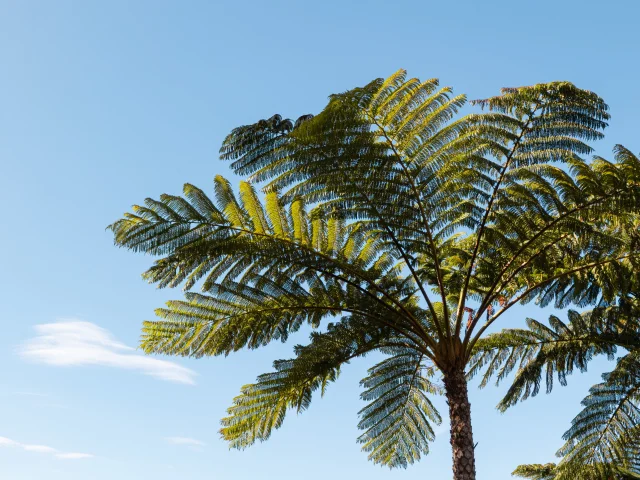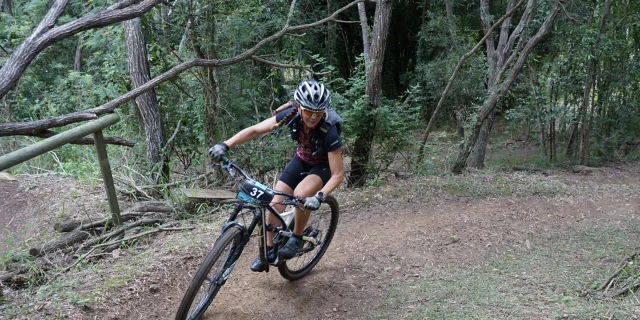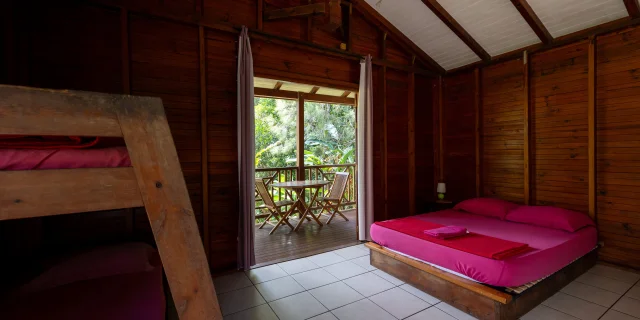Must-see places
Listed in the Top 10 must-sees in New-Caledonia !
 default
defaultListed in the Top 10 must-sees in New-Caledonia !
The forest massif of the park extends into the terrestrial part of the West Coastal Zone (WCZ), a UNESCO World Heritage site. In the interior, a bountiful dense rainforest boasts a 70% endemism rate and exceptional biodiversity. The Parc des Grandes Fougères was created in 2008 to protect the ecosystems found in New Caledonia. In addition to the area open to the public, the park also includes a conservation area, and a space dedicated to hunting deer and wild pigs, two invasive species that threaten the ecosystem.
To see the famous cagou, take the trail that leads to the creek at the bottom of the valley. Visitors are often meeting them there ! Otherwise, the easiest way to see them is to ask the park employees where they are when buying your ticket or choose a guided tour of the park.
 Parc Provincial Des Grandes Fougeres Charlotte Bertonneau 0188
Parc Provincial Des Grandes Fougeres Charlotte Bertonneau 0188 default
defaultThe park is home to many species of fern. Among them, the ones called “grandes fougères”, which give the park its name, are the emblems of the area. Also known as “tree ferns”, they belong to the Cyatheales family. In New Caledonia, they often reach heights of over 20 metres! As you stroll through the park, admire their palm-like silhouettes, with their slender trunks and crowns of leaves. Ferns unquestionably reign over the park’s 500 plant species. To fully grasp their beauty, listen to their murmur when a gentle breeze rustles through their leaves…. Many botany specialists, ornithologists, and entomologists regularly come to catalogue and study the park’s specimens, making it a renowned scientific study site.
If the park’s flora is exceptional, its fauna, especially its birds, has earned it the title of Important Bird Area (IBA) from BirdLife International! Cagou, notou, green pigeon, New Caledonian warbler: as you stroll through the park, you’ll come across many species, some of which are now threatened with extinction. Adopt a calm and silent attitude, pay attention to the birdsong, and you’ll notice how they surround you… and observe you!
“To catch a glimpse of the famous cagou, take the trail that leads to the creek at the bottom of the valley. That’s where visitors often find them. Otherwise, it’s best to ask the park’s staff for advice when you buy your entrance ticket or opt for a guided tour of the park.”
With altitudes ranging from 400 to 700 metres, the park offers a variety of landscapes and viewpoints. Panoramas of the Central Range and West Lagoon from the ridges, valley-bottom streams, rainforest, niaoulis, and more. To appreciate it all, numerous trails and tracks have been laid out. Hiking and mountain biking: there’s something for everyone! To find your way around, you can download the trail map from the park’s website, or ask for one at the ticket office. The well-designed map shows the routes, with their levels of difficulty, picnic areas, and main points of interest. In all, no fewer than 40 kilometers of marked trails await you. More than enough reason to come back more than once!
Be sure to check the weather forecast before coming, especially with children. It’s best to hike in dry weather, because when it rains, the trails can quickly become slippery!
For the sports-minded, the mountain biking trails are not without their challenges. Classed as “black” or “red”, they require good physical condition and a bit of training. On the other hand, they provide quick access to wonderful views. Steep ascents alternate with descents, promising thrilling sensations! There are no mountain bike rentals on site, so you’ll need to bring your own. Horseback-riding enthusiasts can indulge themselves with La Foa Randonnée, which organises excursions in the park and throughout the surrounding region!
 Tinavelo Dsc08937
Tinavelo Dsc08937To make the most of your outing to Parc des Grandes Fougères, what better way than to benefit from the knowledge and experience of a passionate local guide? That’s what Marie-Claude Monefara offers with Mêrêsaaba Rando. As a native of the region and a certified guide, Marie-Claude can reveal the secrets of traditional medicinal plants, the trees used for construction, and the symbolism of the forest’s flora and fauna. The guided hike covers a distance of 3 to 5 kilometers.
Another guided tour, this time themed, introduces you to the park’s endemic bird species. Passionate about ornithology, Isabelle created Caledonia Birds to share her love of birds with curious visitors. With her and the observation equipment provided, you’ll learn to spot and listen for notous, yellow-bellied nightingales, green pigeons, and many more species.
Heading to the park at dawn is a great way to enjoy the awakening sounds of nature, bird songs, and animals. The best way to do this is to spend the night in the surrounding accommodation, as the park itself offers no sleeping or camping facilities. Nearby gîtes, houses of refuge, and chambres d’hôtes offer a haven of peace, whether you’re pitching a tent or renting a fully-equipped riverside bungalow. If you can’t find a place in Farino, then Sarraméa, La Foa and Moindou are also accessible.
 Le Refuge De Farino Charlotte Bertonneau 1674
Le Refuge De Farino Charlotte Bertonneau 1674Distance from Nouméa: 1 hour and 45 minutes by car (itinerary)
The entrance is 6 km from the village of Farino